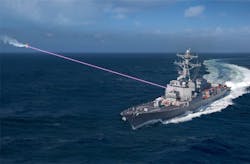Lockheed Martin moves forward with building laser weapons and optical dazzler for U.S. Navy surface warships
WASHINGTON – U.S. Navy surface warfare experts are working toward deploying powerful laser weapons aboard front-line Navy warships with a $20.1 million order announced Tuesday to the Lockheed Martin Laser and Sensor Systems segment in Bothell, Wash.
Officials of the Naval Sea Systems Command in Washington are asking Lockheed Martin Laser and Sensor Systems (formerly Lockheed Martin Aculight) for technical engineering services and sustainment for the High Energy Laser With Integrated Optical Dazzler And Surveillance (HELIOS) system.
The HELIOS laser weapon and laser dazzler project is leading to deployment of this weapon aboard the Navy Arleigh Burke-class destroyer USS Preble later this year -- possibly to be followed by other late-model Burke-class destroyers.
In 2018 Lockheed Martin won a $150 million contract to design and build two HELIOS test units -- one unit for the destroyer USS Preble, and the other for land-based testing. The contract has options that could increase its value to nearly a billion dollars ($942.8 million).
Related: Laser weapons show their stuff in real-world conditions
Details of the HELIOS system are classified secret, yet the weapon is expected to have at least 65 kilowatts of power, and will be integrated with a lower-power optical dazzler to disable intelligence, surveillance, and reconnaissance sensors.
The laser's power ultimately could be increased to 100 or 150 kilowatts of power before widespread deployment aboard future Burke-class destroyers.
The HELIOS project is a natural outgrowth of the Navy's 30-Watt AN/SEQ-3 Laser Weapon System (LaWS), which was installed in 2014 aboard the Navy's USS Ponce, an Austin-class amphibious transport dock ship, where it proved itself able to defend the ship from unmanned aerial vehicles, small boats, and other small targets.
Initial versions of HELIOS will have at least twice the laser power of LaWS, and the system's power is likely to be increased in the future to enable destroyers and other front-line surface warships to defend themselves against swarms of fast boats, manned and unmanned aircraft, sophisticated anti-ship missiles, and perhaps even from ballistic missiles.
Related: Top technology challenges this decade for the warfighter
Late-model Burke destroyers are equipped with long-range missiles that can intercept and destroy ballistic missiles in various phases of flight.
While the HELIOS predecessor LaWS was developed as a prototype to test the feasibility of laser weapons in the ocean environment, HELIOS is being developed from its inception as a full-fledged laser weapon for Navy surface combatants.
On this order, Lockheed Martin will do the work in Bothell, Wash.; Moorestown, N.J.; Owego, N.Y.; Marion, Mass.; Clearwater, Fla.; Manassas, Va.; and other U.S. locations, and should be finished by September 2022.
For more information contact Lockheed Martin Laser and Sensor Systems online at www.lockheedmartin.com/en-us/capabilities/directed-energy.html, or Naval Sea Systems Command at www.navsea.navy.mil.
About the Author
John Keller
Editor-in-Chief
John Keller is the Editor-in-Chief, Military & Aerospace Electronics Magazine--provides extensive coverage and analysis of enabling electronics and optoelectronic technologies in military, space and commercial aviation applications. John has been a member of the Military & Aerospace Electronics staff since 1989 and chief editor since 1995.
